Is your industrial environment as safe as it could be? Jeff Clonts, Tech Application Support Manager at RS, introduces essential industrial safety solutions in each of the five most common product categories — sensors, switches, industrial controls, lighting indication, and facility cleaning & maintenance — to help you identify the most effective solutions for your unique applications.

It’s no surprise that industrial environments like manufacturing facilities are rife with potential hazards, or that safety is a primary concern in these locations. Industrial safety solutions ranging from policies to products are essential to protecting employees and assets from hazards that could result in injuries, trauma, or even death, as well as liability, litigation, reputation damage, equipment and property damage, unscheduled downtime, and costly repairs and production losses.
Creating and maintaining safe and effective industrial environments minimizes the risks inherent to this industry, protects employees and assets from harm, creates a positive and productive work environment, improves efficiency and profitability, and can even reduce insurance premiums and raise employee morale.
Effective industrial safety solutions range from planning and policy procedures intended to establish safety standards and encourage safe practices to product solutions specially designed to control, reduce and eliminate safety hazards. Industrial safety solutions typically fall into one of five categories: sensors, switches, industrial controls, lighting & indication, and facility cleaning & maintenance, and today I’ll introduce you to some essential products in each to help you identify the ideal solutions for safeguarding your industrial environment.
SENSORS
Light Curtains are advanced sensing solutions designed to protect personnel from hazardous machinery while providing more flexibility than physical restraints, such as mechanical barriers and sliding gates, to simplify routine setup, maintenance, and repair work. Light curtains feature a photoelectric transmitter that emits a series of parallel, pulsed, sequenced, and modulated infrared light beams. When an opaque object prevents one or more beams from reaching the receiver unit, indicating that the safety area has been breached, the control logic sends a stop signal to the guarded machine. Unlike standard sensor solutions, light curtains also feature self-checking circuitry to monitor for internal faults. If an internal fault is detected, the light curtain will send a stop signal to the guarded machine and enter lockout mode, which can only be rectified by replacing the failed component and resetting the safety device. This feature qualifies light curtains as control reliable devices — or devices capable of achieving a safe state even in the event of a failure within their safety functions — per the Occupational Safety and Health Act (OSHA) and the American National Standards Institute (ANSI).
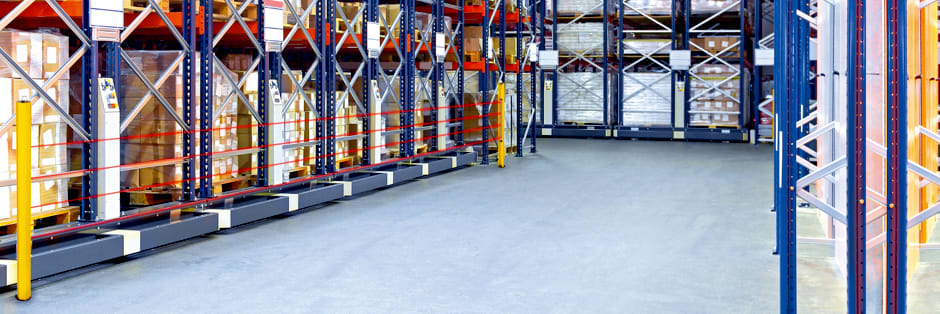
SWITCHES
Emergency Stop Pushbuttons, also known as emergency stop or e-stop switches, are fail-safe control switches designed to force equipment shutdowns when normal shutdown procedures aren’t sufficient for preventing pending hazards or mitigating active hazards to people, machinery, and products. They must be highly visible in terms of color and shape — like the red buttons set against yellow backgrounds mandated by the EN/IEC 60947-5-5, EN/IEC 60204-1, EN ISO 13850, and NFPA 79 standards — and capable of quick, easy and intuitive single-action operation.
Cable-Pull Switches are emergency stop switches optimized for conveyor belts. They connect to the side of conveyors and run the full length of the conveyor belts so operators can pull the cord to stop the belt at any position in the process, even from a distance to the hazard at hand. In addition to conveyor belts, cable-pull switches are used in packaging, paint, and textile manufacturing equipment, transfer machines, presses, and woodworking equipment.
Solenoid Interlock Switches are electromechanical devices that can be used to restrict access to hazardous areas with moving machinery by keeping physical guards, such as gates, grids, and doors, securely locked until the equipment has stopped moving. They can also prevent machinery from starting until physical guards are securely locked.
Both mechanical locking actions rely on energizing the solenoid, which is a small, coiled metal spring, to activate a simple electrical switch that uses a set current to open and close the contacts, lock the actuator in, and hold the guard closed. Due to their locking mechanism, these industrial safety solutions can be mounted closer to the hazard than non-locking switches.
Disconnect Switches are safety devices used to isolate and de-energize electrical circuits for maintenance and quickly disconnect circuits from the power supply in case of emergencies. As such, they are essential for industrial, electrical distribution, and power distribution applications. There are two main types of disconnect switches: fusible and non-fusible switches. Fusible disconnect switches feature multiple fuses in a single enclosure, which makes it easy to manually open and close a circuit, isolate a particular part of a circuit and protect against overcurrent and short circuits. Fusible disconnect switches provide a higher level of circuit and operator safety than non-fusible disconnect switches and are widely used in industrial facilities, commercial buildings, water and wastewater plants, oil & gas applications, and healthcare facilities. Non-fusible, or non-fused, disconnect switches provide a quick and easy way to open and close a circuit but don’t incorporate any fuses in their enclosure, so they don’t provide any circuit protection. Both types of disconnect switches allow for an isolated area of infrastructure to be safely shut down.
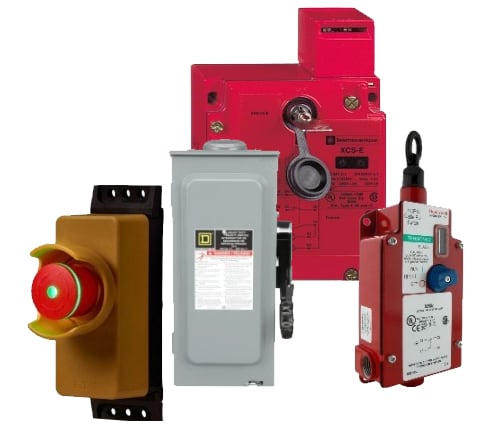
INDUSTRIAL CONTROLS
Safety Laser Scanners are electrosensitive protective devices (ESPE) that use time-of-flight technology to scan a wide detection range in two dimensions using infrared laser beams to protect a hazardous area. As soon as an object appears in the protective field, a safety laser scanner calculates its position based on the amount of time it takes for the laser to bounce off the object and return to the unit and then issues a signal change at the safety output (e.g., at the output signal switching device [OSSD]). Safety laser scanners are typically compact — about the size of a coffee can, which makes them ideal for locations where it would be too difficult to mount light curtains — and are available in variants that comply with Type 3, SIL 2, Category 3, and PLd safety standards. They can be mounted vertically or horizontally and are typically used to prevent equipment in hazardous areas from operating when people or objects are in the danger zone. They can also be mounted on automated guided carts (AGCs) and automated guided vehicles (AGVs) to eliminate the risk of collisions with people or objects in their path.
Safety Relays are used to monitor the integrity of plant functions for potential errors to prevent hazards and, in the event of a hazard, work to reduce the risks to employees and equipment by initiating a safe and reliable response. These compact and high-reliability devices are typically dedicated to monitoring a specific function, output, or measurement, so a single piece of equipment will often have multiple safety relays. Safety relays have open or closed contacts like other relays but, unlike standard relays, they can evaluate and control outputs based on their readings, are subjected to much more rigorous testing procedures and, if they’re installed correctly, will continue to function even if they experience a fault or their sensor malfunctions.
They are also available in single- and multi-function and force-guided variants. Single-function safety relays are used to monitor a specific type of activity in specific types of applications — including two-hand control, muting, and pressure-sensitive safety mat and edge control applications — and can provide both basic and advanced safety functions, such as time delays and speed monitoring. Multi-function safety relays are designed to be used in place of several single-function units and offer benefits including quicker and easier installation, panel flexibility and space savings, and less wiring. Force-guided safety relays feature contacts that are opened and closed by a guide connected to the armature. If a normally open contact in a force-guided safety relay becomes welded, all normally closed contacts will maintain a minimum distance of 0.5 mm when the coil isn’t activated. Similarly, if a normally closed contact becomes welded, all normally open contacts will maintain a minimum distance of 0.5 mm when the coil is energized.
Safety relays are widely employed in applications including two-hand controls, movable guards, light curtains, light barriers and light grids, magnetic switches, safety mats and pressure-sensitive mats, three-position devices, non-contact safety sensors, safety switches, and emergency stop buttons.
Safety Edges and Mats are two popular types of machine guarding tools. Safety edges are touch-sensitive sensors used to protect people and objects from entrapment when used on applications like automatic gates and doors and from injury when used on equipment with shearing or crushing edges. When safety edges detect an obstacle, they immediately stop or reverse.
Many safety edges employ fail-safe normally open or normally closed operating principles but there are also optoelectronic safety edges designed to be used in conjunction with specialized signal processing modules and monitored safety edges designed to detect internal faults.
Safety mats are heavy-duty pressure-sensing mats used to protect people from hazardous areas, like the perimeter of robots, automated assembly equipment, and food processing equipment, and are often installed in place of light curtains or mechanical safety barriers. They feature a set of conductive upper and lower plates, are monitored by a mat controller with output relays used to energize the guarded equipment, and can be wired together in series to create a complete floor-level guarding system. When sufficient pressure is applied to safety mats, typically as little as 5–10 pounds, the conductive plates touch, which de-energizes the output relays and sends a stop signal to the equipment. The output relays also de-energize and send a stop signal to the equipment if a mat is punctured in a way that causes the plates to touch or if the internal wires break, separate from one of the plates, or disconnect from the controller. Safety mats are designed to ruggedly withstand high-velocity impacts and heavy-duty traffic loads of up to 3,000 psi or more and are widely available in non-slip and submersible variants engineered to withstand the harshest industrial environments.
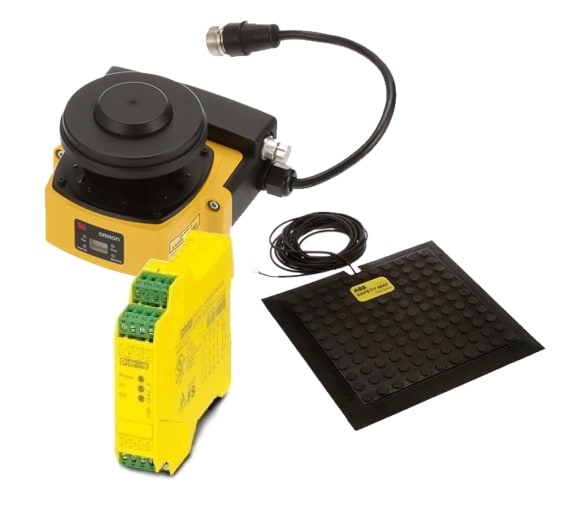
LIGHTING & INDICATION
Facility Lighting includes all of the various types of lighting necessary to facilitate productivity, product quality and employee health and safety in industrial environments and includes:
- Overhead Lighting, such as UFO, linear, and vapor-tight high-bay lights.
- Assembly, Inspection, and Workstation Lighting, such as task lighting, magnification lighting, and vision lighting.
- Machine and Equipment Lighting is typically housed in shatterproof and vapor-tight fixtures.
- Automated Lighting Control Systems that detect activity and adjust the lighting accordingly.
- Indication Lighting, such as LED indicators, strip lighting, in-line status indicators, and tower lights.
- Communication Lighting, such as touch-button indicators and pick-to-light solutions.
For more information about facility lighting, check out our “Five Essential Types of Industrial Lighting Solutions” article at PowerSystemsDesign.com.
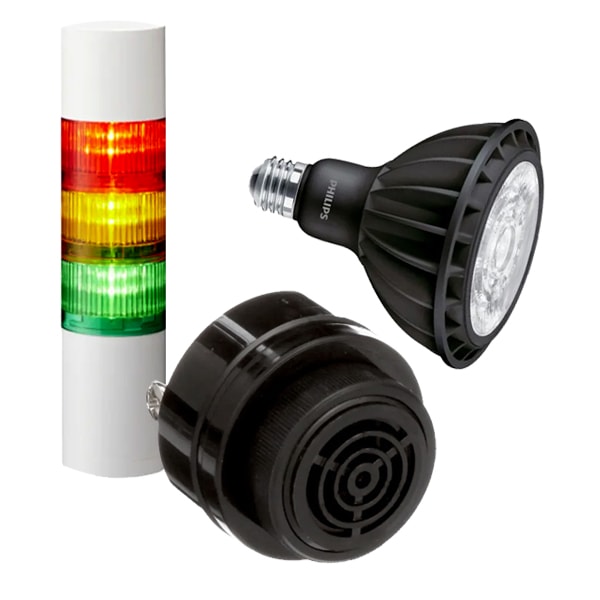
Light Towers are a type of indication lighting used to visually convey the status of various industrial equipment processes. Indication lighting uses different colors and patterns to visually communicate equipment statuses (e.g., warming up, operating, or stopped), assembly process stages, process efficiency, material levels, or the amount of time remaining until the process is complete.
LED towers are the most widely employed indication lighting solutions. These multicolored, multi-segment LED lights are designed to replace conventional stack lights, which typically have complex wiring and, as a result, require time-consuming assembly processes. Industrial LED lighting towers are available in preassembled or configurable variants that let users determine light color, animation, and intensity, as well as in compact, outdoor, quick-disconnect, and pre-wired variants with AC or DC power supplies, audible output options, and various intensities.
Audibles are a vital component of industrial control systems used to alert operators about abnormal conditions and equipment problems so they can take corrective action before harming employees, equipment, or products. Audibles provide signals in the form of audible sound and are often used in conjunction with indication lighting, such as tower lights.
FACILITY CLEANING & MAINTENANCE
Industrial Personal Protective Equipment (PPE)is equipment worn to minimize exposure to workplace hazards that could cause injuries and illnesses, including contact with electrical, mechanical, physical, and chemical hazards. It includes safety glasses and protective eyewear, gloves, earmuffs & earplugs, hard hats, respirators & masks, headliners, first aid kits, lifting belts & safety harnesses, safety shoes & boots, eye wash stations & emergency showers, and safety signs.
Facility Security Solutions including security cameras and monitors, digital video recorders, safety mirrors, door control systems, programmable keypads, and occupancy sensors help protect industrial buildings and equipment from vandalism and theft.
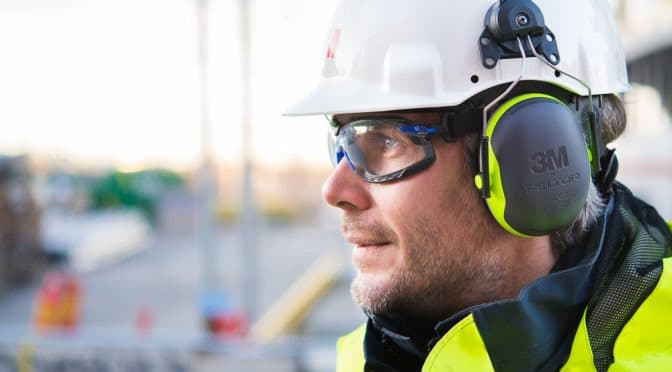
Safeguarding Your Industrial Environment with RS
When it comes to safety, you can’t leave anything to chance. RS offers an extensive selection of ready-to-ship industrial safety solutions from trusted suppliers — including SICK, Eaton, Honeywell, Telemecanique, Square D, Omron, Phoenix Contact, ABB, Philips, PATLITE, Mallory Sonalert, Kimberly-Clark Professional and RS PRO — and can deliver what you need to successfully safeguard your industrial environment when you need it. We also offer a wide range of products ideal for implementing industrial safety solutions, including tools & hardware, test equipment, and wire & cable.
For more information about our extensive portfolio of industrial safety solutions, please visit the links embedded throughout this article. For assistance identifying and deploying industrial safety solutions sure to protect your employees, equipment, and facility, improve morale, and reduce costly downtimes and repairs, please contact your local RS representative at 1.866.433.5722 or reach out to our technical support team.







